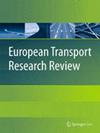轻型电动车:用户与非用户的观点
IF 4.2
3区 工程技术
引用次数: 0
摘要
轻型电动汽车(LEVs),如电动自行车、电动滑板车和电动两轮车,由于其低能量和空间需求,可能有助于向可持续交通系统过渡。本探索性调查研究调查并比较了芬兰、奥地利、西班牙和意大利的城市居民(n = 4090)中LEV使用者和感兴趣的非使用者对车辆优势的看法,以了解影响其采用的因素。此外,还调查了个人车辆和共享车辆之间的差异。方法调查询问受访者最常使用的LEV或他们最感兴趣使用的LEV的优点。在受访者中,26%是LEV用户,37%是对使用LEV感兴趣的非用户,37%是不感兴趣的非用户。形成了旅游的舒适性、可达性、安全性和实用性等因素。对受访者类型(用户与非用户)、LEV类型、LEV是共享的还是个人的、年龄、性别和国家的影响,对每个因素和一些附加变量进行了全因子方差分析。总体而言,lev在旅行舒适性和辅助可达性方面被认为是好的,但在安全性和帮助旅行的实际方面则不太积极。杠杆也被认为是环保的。此外,用户比非用户更积极地感知杠杆,而年龄和性别仅轻微影响观点。结果表明,对杠杆的熟悉程度越高,对杠杆的看法就越有利。现有的积极观点可能导致LEV的使用;然而,经验也可能改变这些观点。杠杆是一种新工具,具有公认的好处,但熟悉度低可能会阻碍采用。在非用户中增加对电动汽车的熟悉程度可以鼓励使用,潜在地支持从汽车到电动汽车的模式转变,从而帮助过渡到更可持续的交通系统。本文章由计算机程序翻译,如有差异,请以英文原文为准。
Light electric vehicles: the views of users and non-users
Abstract Purpose Light electric vehicles (LEVs), such as e-bikes, e-scooters and electric two-wheelers, can potentially assist the transition to a sustainable transport system due to their low energy and spatial demands. This exploratory survey study investigated and compared the views of LEV users and interested non-users on the vehicles’ advantages in Finland, Austria, Spain and Italy among urban residents (n = 4090) to understand factors influencing their adoption. Additionally, differences between personal and shared vehicles were investigated. Method The survey queried respondents on the advantages of either the LEV they used most often, or the LEV they were most interested in using. Of respondents, 26% were LEV users, 37% were non-users interested in using an LEV and 37% were uninterested non-users. Factors concerning comfort, accessibility, safety, and practicality of travel were formed. The effects of respondent type (user vs. non-users), LEV type, whether the LEV was shared or personal, age, gender and country were examined with a full-factorial ANOVA for each factor and some additional variables. Findings In general, LEVs were regarded well for travel comfort and supporting accessibility, but less positively for safety and assisting with practical aspects of travel. LEVs were also perceived environmentally friendly. Furthermore, users perceived LEVs more positively than non-users, while age and gender only mildly influenced views. The results suggest that increased familiarity with LEVs is associated with more favourable views concerning them. Existing positive views may have led to LEV use; however, experience could have changed these views as well. LEVs are novel vehicles with recognised benefits, but low familiarity may hinder adoption. Increasing familiarity with LEVs among non-users could encourage uptake, potentially supporting modal shifts from the car to LEVs and thus assist the transition to a more sustainable transport system.
求助全文
通过发布文献求助,成功后即可免费获取论文全文。
去求助
来源期刊

European Transport Research Review
Engineering-Mechanical Engineering
CiteScore
9.70
自引率
4.70%
发文量
49
期刊介绍:
European Transport Research Review (ETRR) is a peer-reviewed open access journal publishing original high-quality scholarly research and developments in areas related to transportation science, technologies, policy and practice. Established in 2008 by the European Conference of Transport Research Institutes (ECTRI), the Journal provides researchers and practitioners around the world with an authoritative forum for the dissemination and critical discussion of new ideas and methodologies that originate in, or are of special interest to, the European transport research community. The journal is unique in its field, as it covers all modes of transport and addresses both the engineering and the social science perspective, offering a truly multidisciplinary platform for researchers, practitioners, engineers and policymakers. ETRR is aimed at a readership including researchers, practitioners in the design and operation of transportation systems, and policymakers at the international, national, regional and local levels.
 求助内容:
求助内容: 应助结果提醒方式:
应助结果提醒方式:


